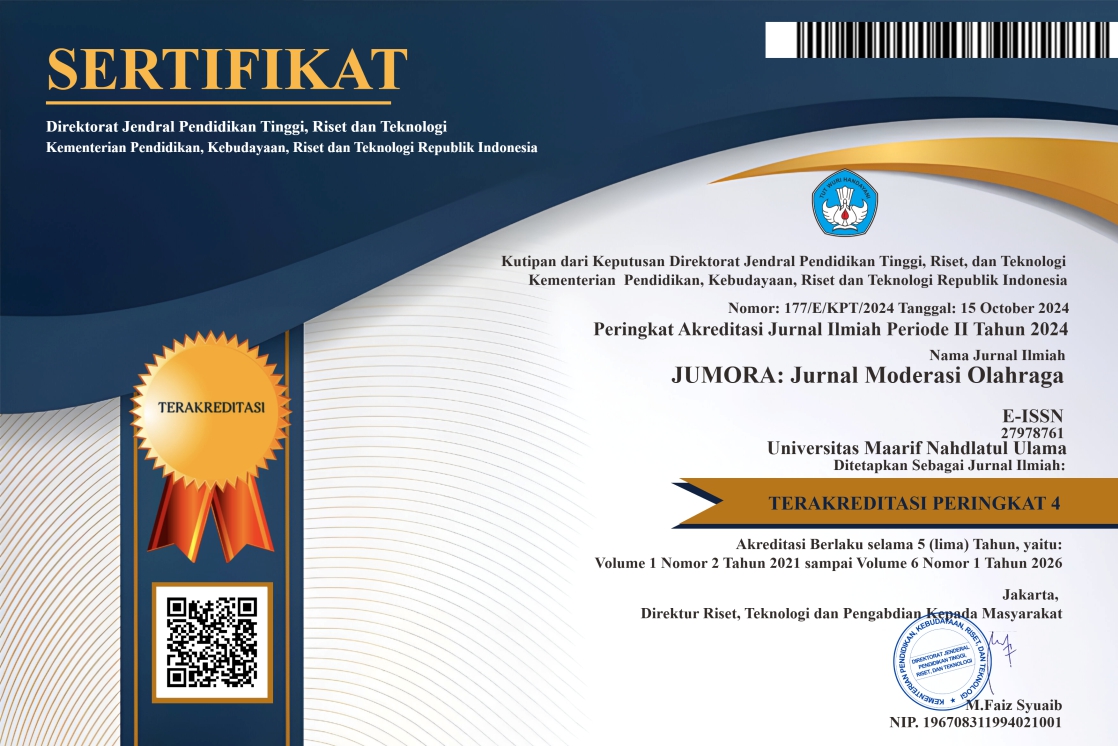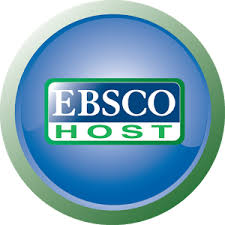Minimizing Level of Oksidative Stress in Martial Arts Atlhetes
DOI:
https://doi.org/10.53863/mor.v4i2.1480Keywords:
Fruit with high levels of antioxidants, stress levels, in martial arts atlhetesAbstract
This study aims to determine the extent of the effect of giving fruit with high levels of antioxidants on reducing stress levels in martial arts athletes. This study used an experimental method with 18 trials using a pretest-posttest control group design, with a true experimental laboratory research type. The sample of this study used 20 martial arts athletes. The subjects were divided into 2 groups, namely the control group and the experimental group (which consumed fruit with high levels of antioxidants). The data obtained came from taking cubital vein blood, then the blood samples were taken to the laboratory to determine the MDA levels using the TBARS method. Data analysis used 3 stages, namely normality test, homogeneity test, and hypothesis test. The results obtained in this study were: 1) The normality test obtained data on the significance value of each group> 0.05 so that the data was normally distributed; 2) The homogeneity test obtained data on the significance value of each group> 0.05 so that the data was homogeneously distributed; 3) The results obtained in this study were that fruit with high antioxidant levels could reduce stress levels in martial arts athletes.
Keywords: Fruit with high levels of antioxidants, stress levels, in martial arts atlhetes
References
A, W. (1996). Radikal Bebas dan Parameter Status Antioksidan. Forum Diagnostikum : Prodia Diagnostics Educational Services. Forum Diagnostikum.
Aguirre, R., & May, J. M. (2008). Inflammation in the vascular bed: importance of vitamin C. Pharmacology & Therapeutics, 119(1), 96–103. https://doi.org/10.1016/J.PHARMTHERA.2008.05.002
Alessio, H. M., Hagerman, A. E., Fulkerson, B. K., Ambrose, J., Rice, R. E., & Wiley, R. L. (2000). Generation of reactive oxygen species after exhaustive aerobic and isometric exercise. Medicine and Science in Sports and Exercise, 32(9), 1576–1581. https://doi.org/10.1097/00005768-200009000-00008
Ambardini, Laksmi Rachmah, & Astuti Indwiani. (2005). Efek pemberian Panax Ginseng terhadap kadar malondialdehyde (MDA) dan Superoxide Dismutase (SOD) darah pada latihan fisik Aerobik intensitas sedang [Universitas Gajah Mada]. https://etd.repository.ugm.ac.id/penelitian/detail/27361
Andrea Putri, B., Pangestu Utami, R., & Indah Mulyaniɜ, R. (2024). Hubungan Status Gizi Terhadap Kelelahan Otot Pada Atlet Bela Diri di SKOI Samarinda Relationship of Nutritional Status to Muscle Fatigue in Martial Arts Athletes in SKOI Samarinda. Indonesian Food and Nutrition Research Journal, 1(2), 2024.
Cipryan, L. (2017). IL-6, Antioxidant Capacity and Muscle Damage Markers Following High-Intensity Interval Training Protocols. Journal of Human Kinetics, 56(1), 139–148. https://doi.org/10.1515/HUKIN-2017-0031
Febrianti, N., Yunianto, I., Dhaniaputri Terbitan Bulan Mei, R., & Bioedukatika, J. (2015). Kandungan Antioksi dan Asam Askorbat pada Jus Buah-Buahan Tropis. JURNAL BIOEDUKATIKA, 3(1), 6–9. https://doi.org/10.26555/BIOEDUKATIKA.V3I1.4130
George, O., B., Osharechiren, & I., O. (2009). Oxidative stress and antioxidant status in sportsmen two hours after strenuous exercise and in sedentary control subjects. African Journal of Biotechnology, 8(3), 480–483. https://doi.org/10.5897/AJB2009.000-9083
Getoff, N. (2007). Anti-aging and aging factors in life. The role of free radicals. Radiation Physics and Chemistry, 76, 1577–1586. https://doi.org/10.1016/j.radphyschem.2007.01.002
Glangkarn, S. (2015). Antioxidant Activity in Red Dragon Fruit Jelly. Food and Public Health, 5(5), 203–206. https://doi.org/10.5923/J.FPH.20150505.06
Güzel, N. A., Hazar, S., & Erbas, D. (2007). Effects of Different Resistance Exercise Protocols on Nitric Oxide, Lipid Peroxidation and Creatine Kinase Activity in Sedentary Males. Journal of Sports Science & Medicine, 6(4), 417. https://pmc.ncbi.nlm.nih.gov/articles/PMC3794479/
Heza Fuad Noor, Wahono Bayu Suko, & Festiawan Rifqi. (2020). Antioksidan Untuk Olahraga Kesehatan. Jurnal Pendidikan Kesehatan Rekreasi, 6(2), 200–205. https://ojs.mahadewa.ac.id/index.php/jpkr/article/view/738/674
Iga Maharani, A., Riskierdi, F., Febriani, I., Alsyah Kurnia, K., Aulia Rahman, N., Fadila Ilahi, N., & Alicia Farma Biologi, S. (2021). Peran Antioksidan Alami Berbahan Dasar Pangan Lokal dalam Mencegah Efek Radikal Bebas. Prosiding SEMNAS BIO.
Ji, L. L. (2002). Exercise-induced modulation of antioxidant defense. Annals of the New York Academy of Sciences, 959, 82–92. https://doi.org/10.1111/J.1749-6632.2002.TB02085.X
Khan, M. I. (2016). Plant Betalains: Safety, Antioxidant Activity, Clinical Efficacy, and Bioavailability. Comprehensive Reviews in Food Science and Food Safety, 15(2), 316–330. https://doi.org/10.1111/1541-4337.12185
Kojo, S. (2004). Vitamin C: basic metabolism and its function as an index of oxidative stress. Current Medicinal Chemistry, 11(8), 1041–1064. https://doi.org/10.2174/0929867043455567
Popovic, L. M., Mitic, N. R., Miric, D., Bisevac, B., Miric, M., & Popovic, B. (2015). Influence of vitamin C supplementation on oxidative stress and neutrophil inflammatory response in acute and regular exercise. Oxidative Medicine and Cellular Longevity, 2015. https://doi.org/10.1155/2015/295497
Samichah, & Syauqy, A. (2014). AKTIVITAS ANTIOKSIDAN DAN PENERIMAAN ORGANOLEPTIK YOGHURT SARI WORTEL (DAUCUS CARROTA L). Journal of Nutrition College, 3(4), 501–508. https://ejournal3.undip.ac.id/index.php/jnc/article/view/6843/6570
Wayan Eka Rahayu Dewi, N., Made Jawi, I., Irawan Nugraha, G., & Hilmanto, D. (2018). Effect of Purple Sweet Potato Consumption to Histological Overview of Mice Liver After Maximum Physical Activity. J Indon Med Assoc, 68(2), 77.
Widyaningsih, W., Sugiyanto, Pramono, S., & Sitarina, W. (2016). PENGKAJIAN AKTIVITAS KARDIOPROTEKTIF, ANTIOKSIDAN DAN ANTIAPOPTOSIS EKSTRAK ETANOL TERSTANDAR MELATONIN DARI GANGGANG HIJAU (Ulva lactuca L) [Universitas Gajah Mada]. https://etd.repository.ugm.ac.id/penelitian/detail/102448
Winarsi, H. (2007). Antioksidan alami dan radikal bebas potensi dan aplikasinya dalam kesehatan (1st ed.). Kanisius.
Wu, L.-C., Hsu, H.-W., Chen, Y.-C., Chiu, C.-C., Lin, Y.-I., & Ho, J.-A. A. (2006). Title Antioxidant and antiproliferative activities of red pitaya. Citation Food Chemistry, 95(2), 319–327.
Yavari, A., Javadi, M., Mirmiran, P., & Bahadoran, Z. (2015). Exercise-Induced Oxidative Stress and Dietary Antioxidants. Asian Journal of Sports Medicine, 6(1), e24898. https://doi.org/10.5812/ASJSM.24898
Zare, M., Shoaei, N., Karimian, J., Nouri, M., Zare, S., Leilami, K., Shateri, Z., Sarbakhsh, P., Eftekhari, M. H., & Pourghassem Gargari, B. (2024). Effect of a plant-based diet on oxidative stress biomarkers in male footballers. Scientific Reports 2024 14:1, 14(1), 1–10. https://doi.org/10.1038/S41598-024-54198-3
Downloads
Published
How to Cite
Issue
Section
License
Copyright (c) 2025 Abdul Latif Rahman Hakim, Fajar Adi Nugroho, Kartika Septianingrum

This work is licensed under a Creative Commons Attribution-ShareAlike 4.0 International License.
Authors retain copyright and grant the journal right of first publication with the work simultaneously licensed under a Creative Commons Attribution-ShareAlike 4.0 International License that allows others to share the work with an acknowledgment of the work’s authorship and initial publication in this journal











